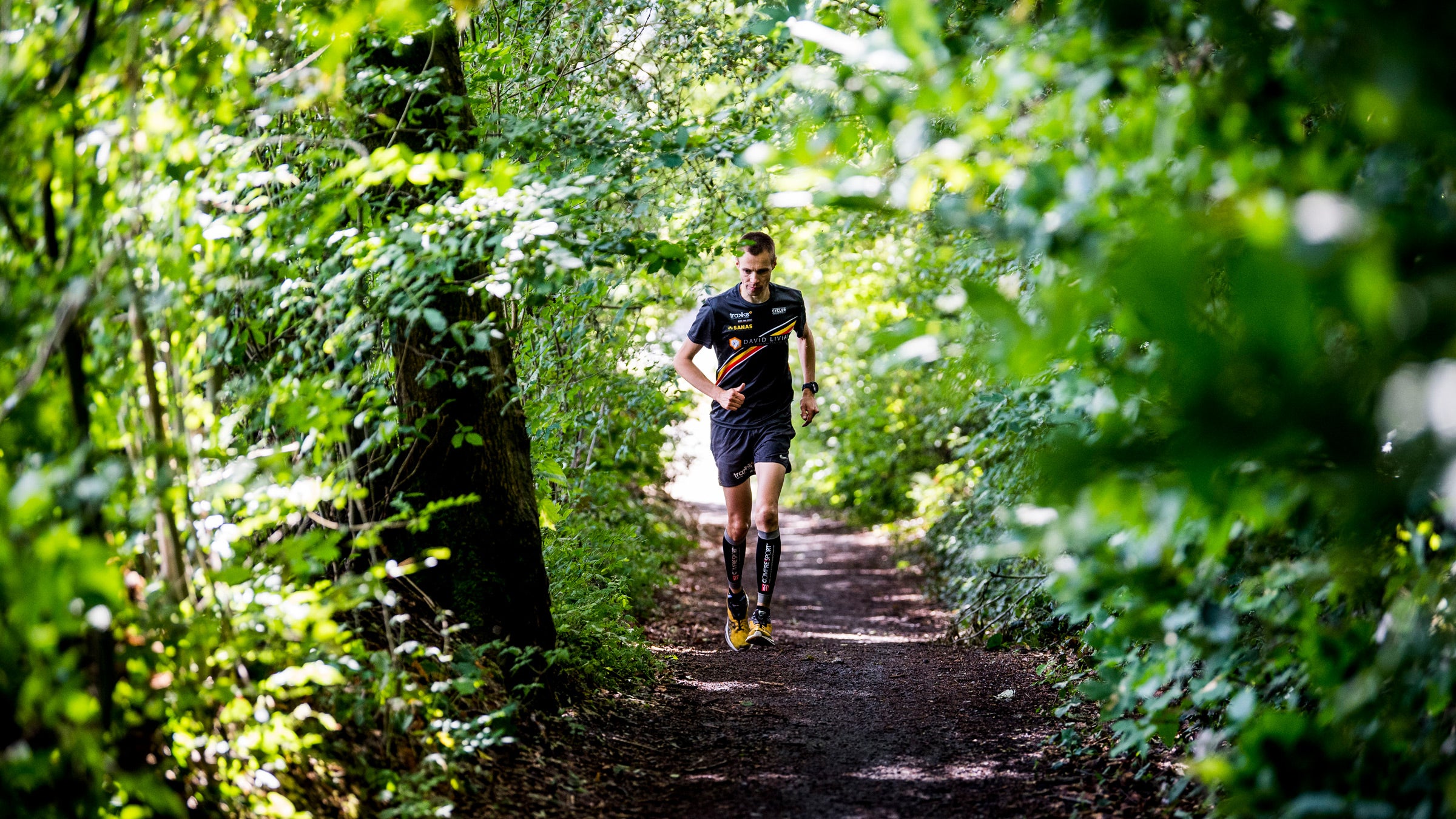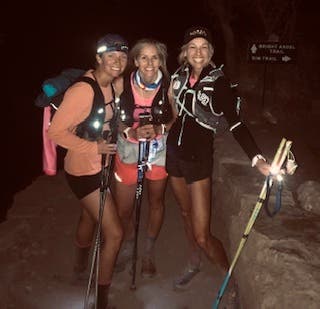The Craziest COVID Challenges Keeping Us Going This Year

Ultrarunner David Liviau does the Everest Challenge. (Photo: Jasper Jacobs/ Getty Images)
They say character is who you are when no one’s watching. So this year, when definitely no one was watching—there weren’t many races or organized events during the COVID pandemic-what did our characters reveal?
It turns out triathletes across the globe proved their characters by creating their own COVID-friendly challenges. Whether it was traversing the Grand Canyon (and back) or completing a solo-supported Ironman, triathletes did not give up. They geared up and got it done, whatever “it” was. Here were some of our favorite of the crazy challenges athletes took on. Maybe you’ll find some inspiration—and let us know how your own challenge goes.
Everesting
One of the most popular challenges of the year is what is known as “Everesting.” Everesting involves climbing the same number of vertical feet as it takes to get to the top of Mt. Everest—approximately 29,028—in one day.
The most common way to Everest is by bike, with records being broken by pro cyclists throughout the year. Early in the year, pro triathlete Sam Long also achieved the feat in just over 10 hours on his triathlon bike.
But some people took Everesting to the next level by tackling it on foot.
Danny Foerster, a triathlete from Bozeman, Montana, completed the Everest challenge via hiking and trail running. It took him 21 hours and 47 minutes.
“I chose a short and steep section of a trail close to town,” said Foerster. “The trail is a half-mile long, but climbs 850 feet. It took me 34.8 ‘laps’ to achieve a vertical gain of 29, 245 feet.”
DIY Ironman
We wouldn’t really be triathletes if we didn’t hanker for the good ole’ pain of the 140.6 mile journey that is an Ironman. Even as Ironman races were cancelled on a global scale, triathletes didn’t let that crush their red carpet dreams.
Whether it was athletes completing iconic DIY races like Ironman Lake Placid on the actual course, or going with a totally homemade approach, plenty of triathletes can still say they finished an Ironman this year.
Stuart Selber of State College, Pennsylvania, designed his own Ironman, called the Covidman State College, after his “A” race, Ironman Maryland, was canceled.
“My thinking was that I needed something normal in my life as the world turned upside down,” he said. “That was a good call.”
Selber also noted that having the constant of training for something (even if it was less glamorous than usual race fanfare) helped him stay anchored as the world became increasingly unpredictable—and we’d guess most triathletes would agree.
Getting to Know the Neighborhood
With all of us spending more time at home, it’s natural to get a bit cabin crazy. Some athletes took that as a sign to become friendly with their locales.
Whether it was running a New York City borough to completion or traversing an entire state, it’s highly likely you passed by one of these neighborhood runners at some point this year.
Paul Davies is a 24-time marathoner and Bostonian with a penchant for getting to know his city on foot. Although he started before the pandemic, Paul completed his trek of running every single street in Boston this fall. In total, he covered 4,400 streets, 1,748 miles, 74,720 feet of gain over 17 months and 320 runs. Whew!
FKTs
In triathlon, we have course records. In trail and ultrarunning, there are Fastest Known Times, or FKTs.
Numerous FKTs have been broken this year as triathletes and runners alike tested their abilities on some of the world’s most famous routes: the Appalachian Trail, the Skyline Traverse, the Pacific Crest Trail.
Skipping the swim and bike portion of a race, many triathletes nationwide shored up the soles of their shoes and headed out for local FKTs.
Jennifer Kirkpatrick achieved the FKT of the Northeast Texas Trail (NETT) this past May. It took her one day, 22 hours, and 51 minutes to cover 139 miles of dense Texas woodlands. Unlike well-structured triathlons, FKTs can often get a little gnarly.
“I only slept five minutes total,” said Kirkpatrick. “I had raging poison ivy from my knees down and hallucinated that there were little kitten heads singing to me on the trail.”
The Alternative At-Home Course
Speaking of FKTs, some folks took the idea of an at-home route to a whole new level during quarantine.
Whether it was Everesting on a treadmill for 15 hours straight, completing 60 miles on a treadmill over 19 hours, or finding a creatively small loop on which to run, triathletes and runners once again demonstrated their unbreakable spirits and devotion to athleticism by testing their limits.
Jamil Coury, for example, is a well-known ultrarunner who likes to do things that would elicit a strong “no thanks” from the rest of us. This year, as races dropped like flies, Coury completed an entire marathon on a helipad where each loop was just .017 of a mile.

It took him 1,563 laps to achieve the 26.2 miles.
“I’ve always been fascinated by short loop ultra marathons,” said Coury. “I have a friend who wants to compete in a 24 hour event with me on the helipad. That may happen now that the temperatures in Phoenix have begun to cool off.”
The most impressive thing here is that Coury didn’t fall over from dizziness.
Backyard Ultras
Similar to finding at-home alternative run routes, lots of people became inspired to create their own Backyard Ultramarathons (a race of 50K distance or more), often benefitting good causes.
Dr. Sam Snyder of Anchorage, Alaska ran 53.5 miles around a 1.1-mile pond in his backyard in May. He raised $7,000 for foster care needs and support in the process. Ashley Donovan of Washington ran 86 miles over 24 hours in a 0.2-mile parking lot to raise money for fellow EMTs and first responders like herself. There are tons of other stories of endurance-minded people using their athletic powers for good by raising money for thoughtful causes during the pandemic.
And, of course, we have to include ultrarunning legend Courtney Dauwalter, who ran 283.33 miles over 68 hours at Big’s Backyard Ultra in October—a race with no finish line; last person standing wins.
Rim to Rim to Rim
The Grand Canyon is grand for a reason. Crossing it from one rim to the other, and then back is about 48 miles (depending on your route) with about 21,000 feet of elevation gain. Grand, indeed.
Triathletes and ultrarunners alike descended on the Grand Canyon this year to test their fortitude with the Rim to Rim to Rim (R2R2R for short) challenge; crossing the Grand Canyon, and back. The trek can be done in one sleepless day or broken into two.

Kelsey Combes, a veteran triathlete, completed the R2R2R challenge in late October. “It took us 19 hours total with 17 hours of moving time,” she said. “In total, we traveled 52 miles with 11,000 feet of elevation gain and 11,000 feet of elevation loss.”
Combes said of her motivation to attempt the challenge:
“With triathlon racing and training in the past, I had been worried about injuring myself on a trek like this, so I never made it a priority,” said Combes. “This year, Rim to Rim to Rim was the challenge and adventure I needed to keep me sane without races.”